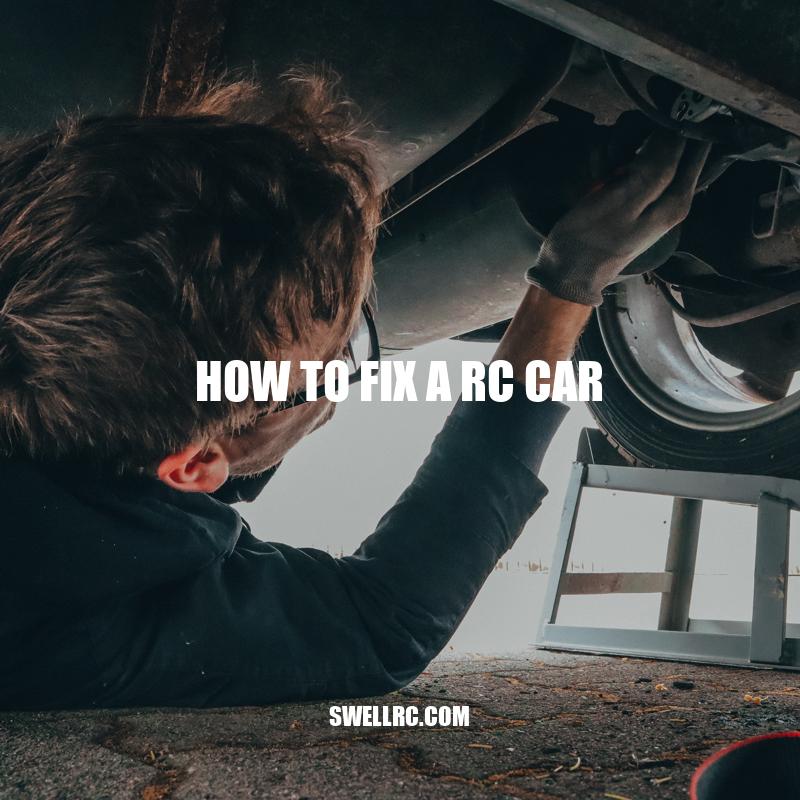Fix Your RC Car: A Comprehensive Guide
RC cars are widely popular among people of all ages, from children to adults. They can be used for recreational purposes or competitive racing events. However, like any other machine, RC cars can experience issues that require fixing. Knowing how to fix an RC car is crucial to keep it running optimally and prolong its lifespan. Most problems with RC cars can be easily diagnosed and fixed by following simple steps. This article provides a comprehensive guide on how to fix an RC car. It explains how to diagnose the problem, the tools and equipment needed, how to fix the problem, running tests, and preventing future problems. By following this guide, readers will learn how to troubleshoot and fix a range of issues that may arise with an RC car. They will be able to repair their RC car more efficiently and effectively.
Diagnosing the problem
Before attempting to fix an RC car, it’s essential to identify the problem accurately. Here are some common RC car issues and their symptoms:
- Battery problems – the car doesn’t run or runs slower than usual
- Transmission issues – grinding noises, car not shifting gears or jerky movements
- Motor problems – car stops suddenly or doesn’t run smoothly
- Servo problems – car doesn’t turn or steer correctly
- Suspension issues – car bounces excessively, or the wheels don’t align correctly
There are several ways to diagnose the problem with an RC car, including:
- Listening for unusual noises while running the car
- Inspecting the car and its components for any visible damage or wear and tear
- Using a multimeter to test the battery voltage and motor
- Running controlled tests to replicate car behavior on different surfaces or terrains
Once the problem is identified, fixing it becomes a lot easier. Nevertheless, the next step requires the right tools and equipment to get the job done.
Why Won’t My RC Car Work?
If your RC car isn’t working, the issue could be one of many things. Here are a few things to check:
- Is the battery charged?
- Are the batteries in the remote control fresh?
- Is there anything blocking the wheels from turning?
- Are the connections between the battery and motor secure?
- If it uses fuel, is the tank full and is the fuel mixture correct?
If you’ve checked all of these things and your RC car still isn’t working, it may be time to consult with a professional or the manufacturer’s website for troubleshooting tips or further help.
Tools and Equipment Needed
Now that you have identified the problem, it’s time to get the necessary tools and equipment to fix it. Here’s a list of essentials:
| Tool/Equipment | Purpose |
|---|---|
| Screwdriver set | To dismantle the car body and access the internal components |
| Multimeter | To measure electrical voltages, resistance, and continuity in the car’s battery, motor and receiver connections |
| Soldering iron | To make quick repairs or replacements of damaged wires and circuits |
| Hex wrench set | To loosen and tighten screws on the wheels, motor and suspension components |
| Tape (doublesided, masking, and electrical) | To make quick temporary repairs, protect wires against short-circuiting or hold components in place |
You can purchase these tools and equipment on various online stores such as Amazon or local hobby stores that sell RC car parts and accessories.
Remember, having high-quality tools makes it easier to fix the problems and reduce the chances of further complications.
What Tools and Equipment are Needed?
To produce high-quality content, the following tools and equipment are recommended:
- A computer or laptop and a reliable internet connection.
- A word processor such as Microsoft Word, Google Docs, or Apple Pages.
- A grammar and spell checker such as Grammarly or Hemingway.
- A content management system (CMS) such as WordPress, Joomla or Drupal.
- Reference materials such as dictionaries, thesauruses, and style guides.
- A noise-cancelling headset or earplugs to minimize distractions.
Additionally, if you include visuals or graphics in your content, you might also need:
- A camera or smartphone with a good camera.
- An image editing software such as Adobe Photoshop or free online tools like Canva or Pixlr.
Overall, having the right tools and equipment can greatly improve your writing efficiency and quality of content.
Fixing the Problem
Now that you have diagnosed the problem and gathered the necessary tools, it’s time to fix the issue. Here are the steps to follow:
Step 1: Dismantling the Car Body
- Remove the screws or clips holding the car body
- Detach the electronics components such as the receiver, battery, and motor from the body
- Disconnect and label wires coming from the components. This makes it easier to reconnect them later
Step 2: Identifying the Problem Component
- Inspect the components such as the receiver, battery, and motor for damages and corrosion
- Check the wiring connections between the components for loose or frayed wires
- Use a multimeter to measure the voltages and resistance between the components
Step 3: Fixing the Issue
- Replace damaged components: If a part such as the battery, motor or radio transmitter is damaged, buying a new replacement from a hobby store or the manufacturer is the most feasible solution
- Repairing loose wires: Use a soldering iron or electrical tape to fix frayed, loose or disconnected wires gently
- Cleaning corroded parts: Use a clean cloth or brush to clean corroded parts to remove rust and dirt. To prevent corrosion, apply a light layer of silicone grease on electrical connectors
Remember to test the car after all repairs and make adjustments where necessary. Some RC cars require specific skills like programming, so be sure to follow the manufacturer’s guidelines or seek the assistance of an expert. RC Planet and Horizon Hobby are excellent places to find replacement parts, and they offer a broad range of supplies, upgrades, and expert support.
How Do You Dismantle a Car?
Dismantling a car is not an easy task, but it can be done with the right approach and tools. Here’s a step-by-step guide on how to dismantle a car:
- Remove the wheels, including the nuts and bolts.
- Disconnect the battery and isolate it to prevent any short circuit.
- Drain all fluids such as fuel, oil, coolant, and brake fluid.
- Remove the engine, transmission, and exhaust system.
- Take out any wiring, hoses, belts, and other accessories.
- Remove the interior components such as the dashboard, seats, and carpeting.
- Extract the glass, mirrors, and headlights.
- Finally, use a hydraulic shear or similar device to cut the car into smaller, manageable pieces.
It’s important to wear protective gear such as gloves and goggles when dismantling a car. Make sure to properly dispose of all hazardous materials and recycle any salvageable parts.
If you’re looking for car dismantling services or products, there are many websites and companies that offer professional dismantling and recycling services.
Running Tests
After fixing the RC car, you need to check whether the problem has been resolved. Here are some tests you can perform:
Battery Test
- Ensure the battery is fully charged then attach it to the receiver
- Turn the car on and check if the motor and other electronics are responding correctly
Motor Test
- Attach the motor to the ESC (Electronic Speed Controller) and connect the ESC to the receiver
- Start the car and check if the motor is running smoothly and at the correct speed.
Receiver Test
- Attach a servo to the receiver’s servo output plug
- Turn on the controller and check if the servo is responding to the controller’s movements as expected
Remember to properly calibrate the controller before running any tests. If you find that the car is still having problems after performing these tests, don’t hesitate to contact an expert in RC car repairs for assistance. Additionally, experts recommend testing your car periodically for any issues before going for a run. This helps fix any underlying issues before causing severe damage to your car.
What to check when checking a car?
When you’re buying a used car, it’s essential to know what to look for before parting with your cash. Here are a few key things to check when inspecting a car:
- Exterior condition, including any signs of rust, paint damage or dents.
- Tire tread depth and overall condition, including sidewall damage or bulges.
- Fluid levels, including oil, coolant, and brake fluid.
- Functionality of lights, indicators, and windscreen wipers.
- Test drive the car to check brakes, suspension, steering, and engine performance.
For more detailed advice, check out websites like carfax.com or edmunds.com, which offer comprehensive vehicle history reports and guides to buying used vehicles.
Preventing Future Problems
It’s essential to take preventive measures to keep your RC car working optimally. Here are some tips to help prevent future problems:
Proper Maintenance
- Regularly clean and lubricate the RC car’s moving parts
- Store the battery in a cool and dry place
- Replace the battery when it starts to show signs of wear and tear
Upgrades
- Upgrade the motor, battery, or other components for better performance and durability
- Install a stronger and more reliable gear to prevent gear failure
Careful Driving
- Avoid driving the RC car on rough or uneven surfaces to prevent damage to the components
- Keep the car away from water, excessive heat, and direct sunlight, which can damage sensitive electronics
- Implement safe driving practices to prevent collisions with other objects or cars
By following these tips, you can keep your RC car functioning optimally for a long time. Additionally, there are many websites and forums online that offer advice on how to maintain and fix your RC car.
How do you maintain an RC car?
Maintaining an RC car is crucial to ensure its optimal performance and longevity. Here are some tips to maintain your RC car:
- Keep your RC car clean and free from debris and dust buildup after each use.
- Regularly check and replace the batteries in the transmitter and the car.
- Check and tighten all screws, nuts, and bolts on a regular basis to prevent loosening and damage to the car.
- Inspect the tires and wheels for any damage, wear, or tear before and after each use.
- Regularly lubricate the moving parts of the car to reduce friction and prevent wear.
For more information on maintaining your RC car, check out websites such as RC Driver or products such as the Traxxas Maintenance Kit.
Conclusion
By following the steps outlined in this article, you can diagnose and fix most common problems that your RC car may face. Remember to take the necessary preventive measures to keep your car running smoothly and avoid future issues.
As you become more familiar with your RC car, you’ll be better equipped to identify and fix any emerging problems before they cause significant damage. Remember to follow the manufacturer’s instructions closely and take good care of your car.
In case you face a problem that you are not sure how to fix, don’t hesitate to ask for help from experts. There are many online forums and resources available that you can use to get help. You can also consult your RC car’s manufacturer for support.
Finally, have fun with your RC car! With proper maintenance and care, it can provide you with countless hours of enjoyment, whether you’re racing or simply exploring the environment around you.



